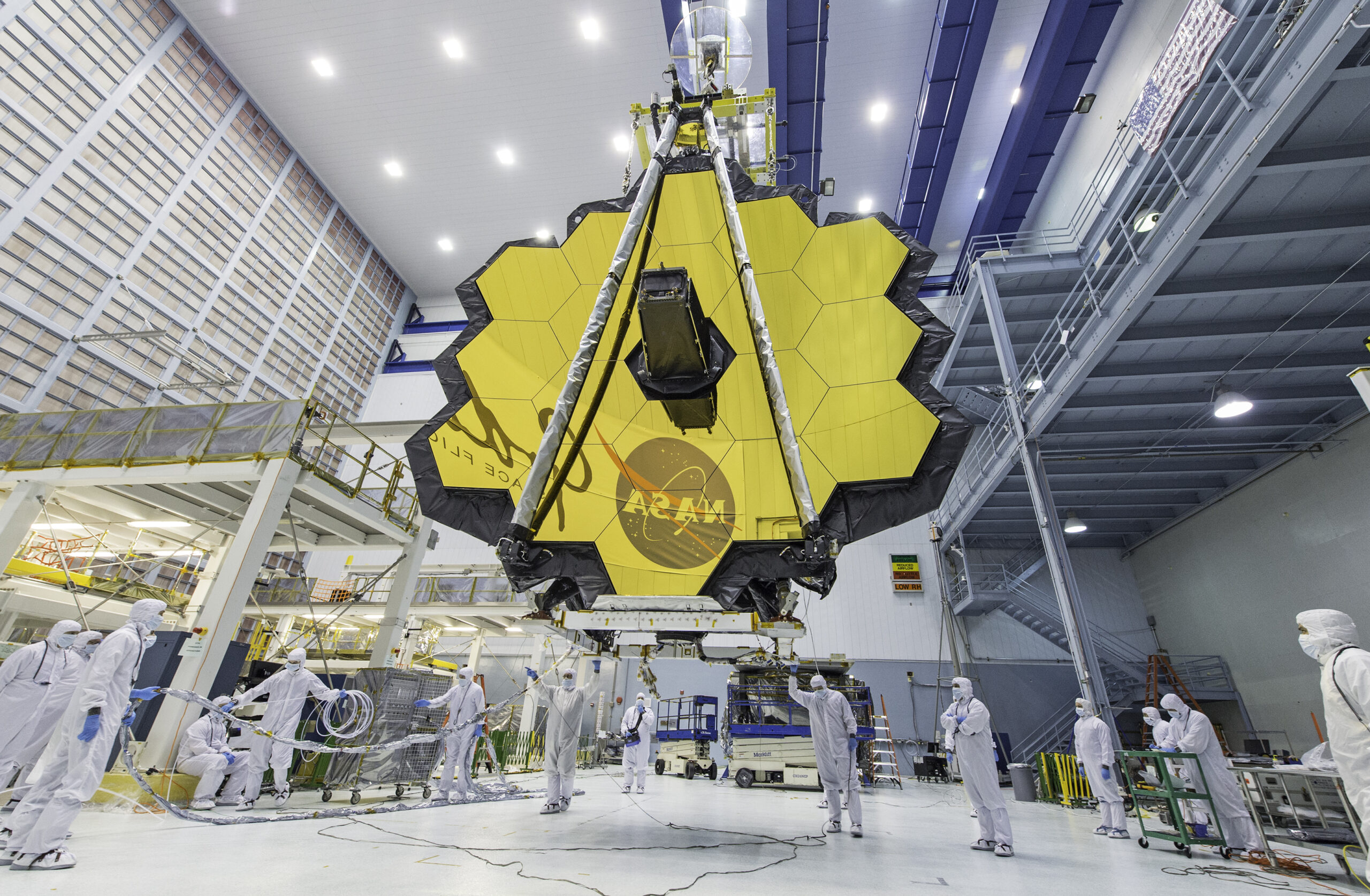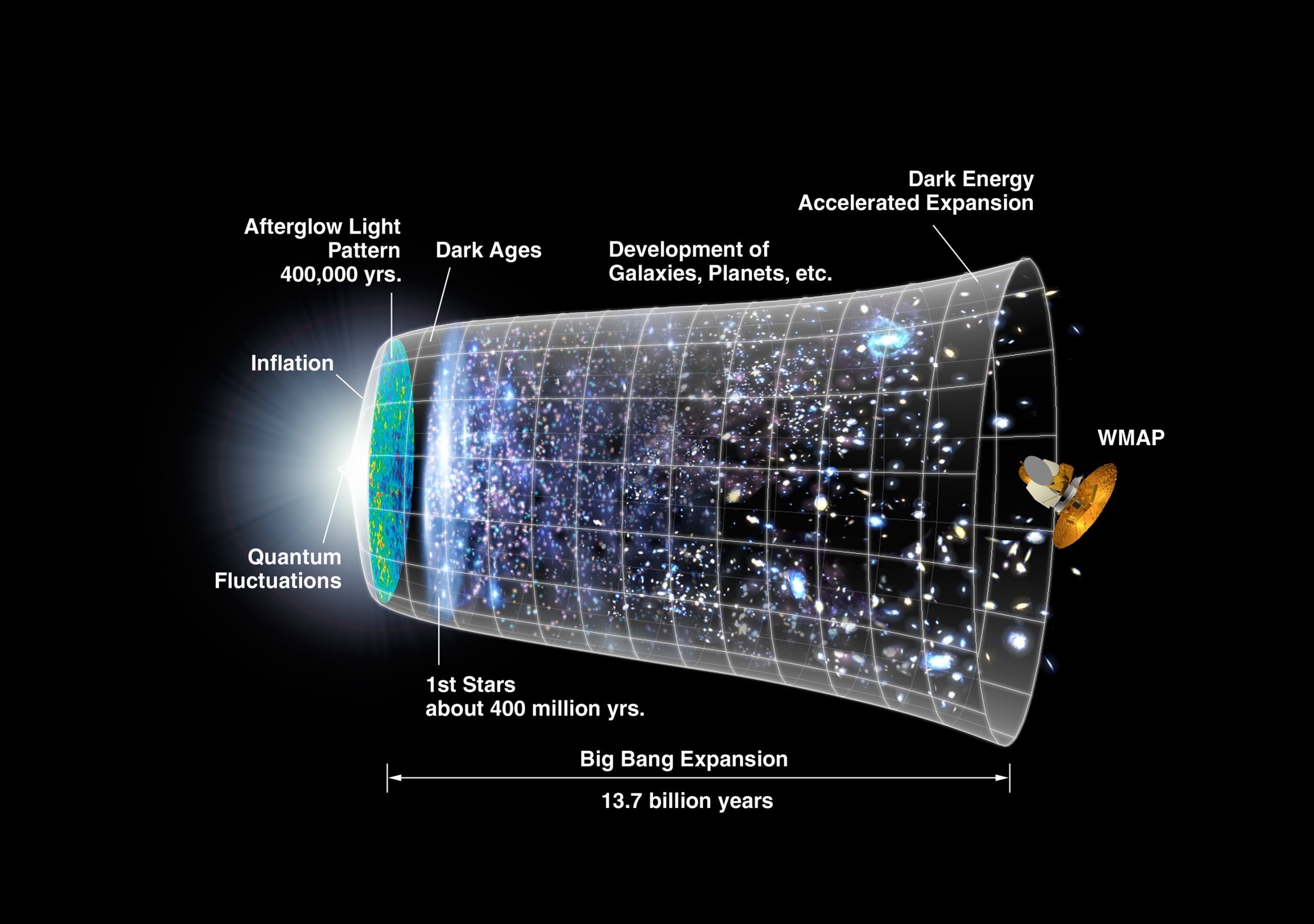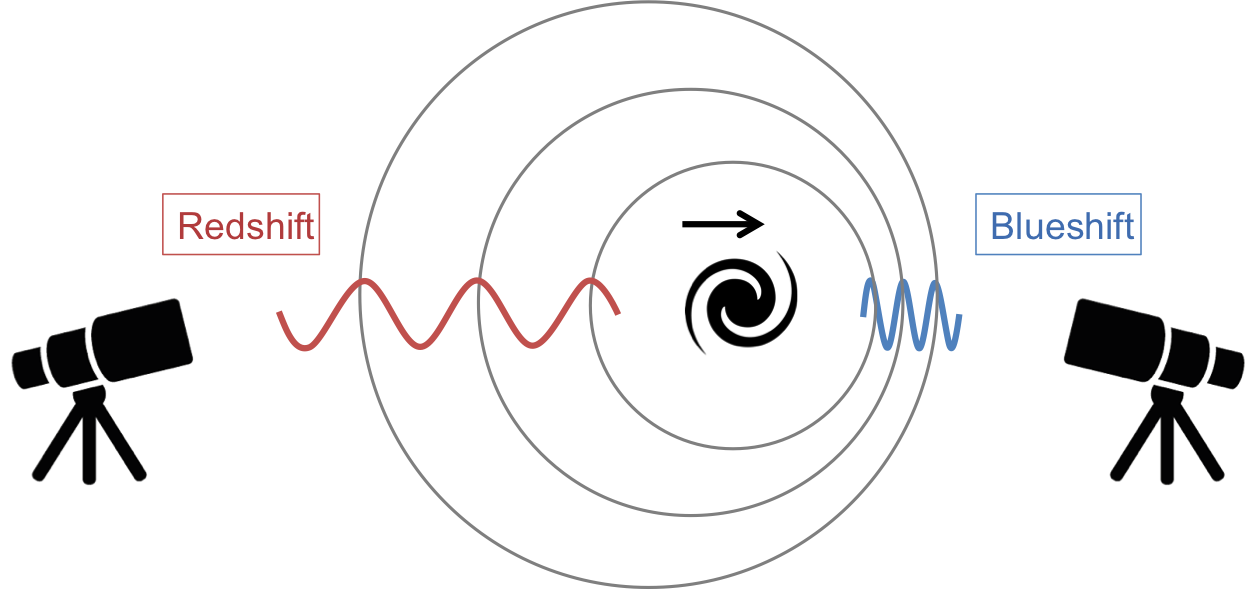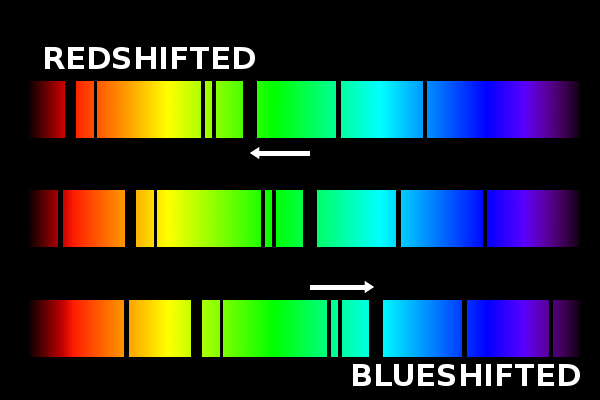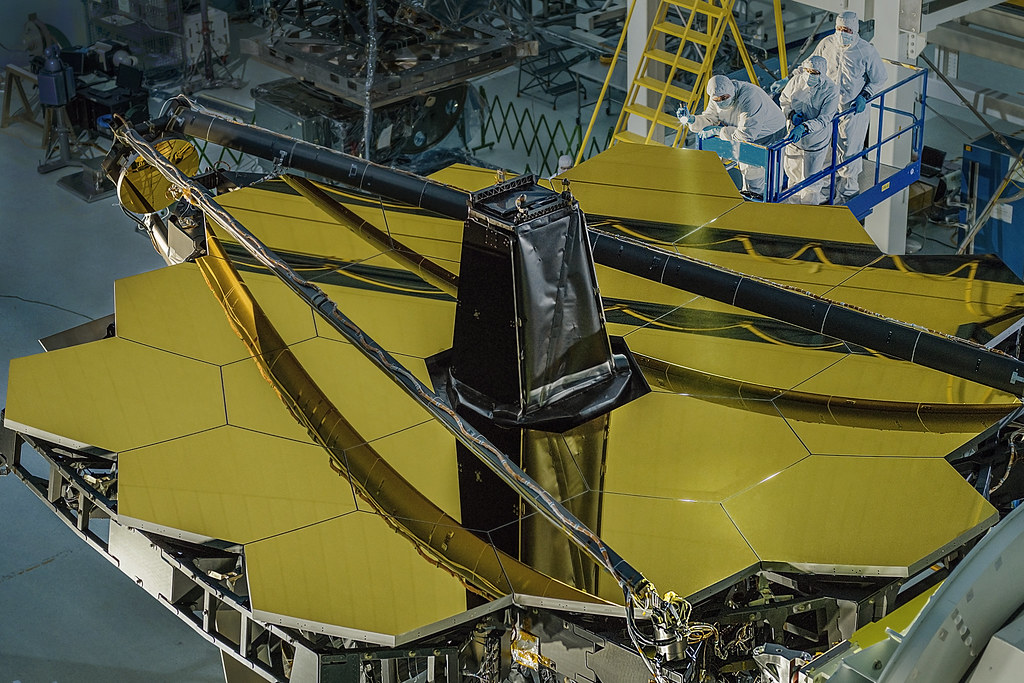By Vincent Jia
Introduction
The desire to fully understand the origins of the universe and the formation of galaxies has been pushing the development and construction of telescopes of various types. Due to the technological limitations of the Hubble telescope and previous models, in 1996, NASA, the European Space Agency, and the Canadian Space Agency decided to develop and construct one of the most sophisticated machines in human history – the James Webb Space Telescope. It was launched into space by an Ariane 5 rocket on December 25th, 2021, beginning its journey of unfolding the mystery of the universe and rewriting cosmic history.
Source: Nasa
Origins of the Universe
It is almost unanimously believed by astrophysicists that the origin of the universe was the Big Bang, after which the universe was filled with various particles. The universe was then insanely hot, at about 5.5 billion degrees Celsius. As the universe started cooling off, electrons, protons and neutrons started to form atoms. After roughly 400 million years, the first star was formed by the fusion of hydrogen atoms and helium atoms. Through a long period of evolution, the solar system was formed 9 billion years after the Big Bang. 4.8 billion years later, life was eventually born on Earth. Therefore, scientists believe that the universe is approximately 13.8 billion years old. Scientists have always been curious about cosmic history. Is there a way for us to see what it was like at the beginning of the formation of the universe?
Source: Alphacoders
To answer this question, we need to first remind ourselves that we are able to see objects because there is light entering our eyes. As a result, in order to see the universe at the early stages of its formation, we need to be able to capture that light and effectively absorb information from it.
When we look up at the sky at night, gazing at countless stars, we are often amazed by the vastness of the universe. We realize that the objects we observe are incredibly distant from us, and the size of the universe is unpredictably large. However, what we often forget when conceptualizing it in our minds is that the distance between us and the stars is not only in space but also in time. The objects we observe on Earth are not what they look like right now but a few minutes or even years ago because it takes time for light to travel from object to object. For instance, the sun is 8 light minutes from us so the sun we see is actually what the sun looked like 8 minutes ago. There is a star called Proxima Centauri which is 4.2 light-years from the earth. Therefore, the Proxima Centauri we observe is what it actually looked like 4.2 years ago. The GN-z11 galaxy, captured by the Hubble Telescope, is 13.4 billion light-years from us, meaning the GN-z11 we see today is the galaxy 13.4 billion years ago, which is exactly 400 billion years after the Big Bang! It was one of the first galaxies created in this universe. So technically speaking, if we are able to observe the light emitted from objects that are far away, we can further our understanding of the creation of the world. The further we are able to see, the more we are able to observe the origins of the universe’s early stages.
Infrared Light
Unfortunately, we can’t directly see the light emitted from objects billions of light-years from us. Remember that light is a wave and only certain wavelengths included in the visible spectrum can be perceived by human eyes. The wavelengths of distant objects are stretched when travelling in space. A great analogy is the Doppler Effect. As the sound of a siren comes towards a person, the person perceives a higher tone, but as it passes the person and moves away, the tone gets lower. When the source of the sound waves comes near, the waves compress against one another, creating a higher frequency. As the source of the sound moves further away, the sound waves stretch and expand, resulting in a lower frequency.
Source: Voyages
The same thing happens with light. Our universe is constantly expanding faster than the speed of light. As a result, the objects radiating the light are moving away from us while sending us that lightwave, stretching its wavelength at the same time. The longer the wavelength, the redder the light. This scientific phenomenon is called redshift. The further a galaxy is, the faster it is moving and therefore the redder it’s light. The light from those distant galaxies has been redshifted out of the visible spectrum to the infrared part of the spectrum. Therefore, light from the very first galaxies is no longer visible to human eyes.
Source: West Texas A&M University
James Webb
Source: Staticflickr
So what type of telescope is needed to uncover cosmic history? The expansion of the universe keeps pushing those already distant galaxies further away from us faster than the speed of light. Therefore, we need to have mirrors with high sensitivity that can collect these glimmering light waves that are incredibly far away. Therefore, a large-diameter telescope is necessary because sensitivity depends on the size of the mirrors. Due to the atmospheric disturbance on Earth, the telescope cannot be situated on the ground but beyond the Earth’s atmosphere. Furthermore, the redshift of the light requires the telescope to have extensive infrared capabilities. Combining all of that, we have the James Webb Space Telescope – the newest generation of observatories that outcompetes all of its previous counterparts. The primary mirror is made of 18 golden giant hexagonal mirror segments with a total diameter of 6.5 metres, the size needed for high sensitivity is because the larger the mirror area, the more light and details it can collect from the vast universe. Each weighing 20 kilograms, the mirror pieces are made of beryllium which is both strong and lightweight.
Source: Staticflickr
The telescope is equipped with The Near Infrared Camera (NIRCam), The Near InfraRed Spectrograph (NIRSpec), and The Mid-Infrared Instrument (MIRI). The NIRCam interprets infrared wavelength range 0.6 to 5 microns and allows astronomers to take pictures of very faint objects around a central bright object s. The NIRSpec disperses light from an object into a spectrum, thus helping scientists find its physical properties, including temperature, mass, and chemical composition. The atoms in the object imprint specific lines on its spectrum that uniquely represent each chemical element. The MIRI is similar to NIRCam and NIRSpec combined, except for longer wavelengths – 5 to 28 microns. It detects and absorbs information from newly formed stars and early galaxies.
Source: James Webb Space Telescope
Source: James Webb Space Telescope
Now we have a sense of what the telescope is equipped with, but how exactly does it work? After being launched into orbit, the telescope faces outside of the solar system, in the opposite direction from the sun to collect light waves and prevent itself from being burned by the incredibly high-temperature sunlight. That’s why it has these huge, aluminium sun shields blocking the sun’s radiation from direct contact with the telescope. The primary mirror (the biggest one) receives light and reflects it off onto the smaller secondary mirror in front of it. The light is then bounced off one more mirror and then goes to the fine steering mirror, which stabilizes the image and compensates for the movement of the spacecraft. The light is finally directed into the various instruments inside the telescope and then analyzed by a number of cameras and spectrometers. The reason the so-called Three Mirror Anastigmat system is being used on the telescope is that it collects the most light. It perceives so much more light than just the instruments or the secondary mirror facing out into space themselves.
After more than 20 years, The James Webb Space Telescope, with its 18 hexagonal mirrors fully aligned, is ready to unfold the past and reveal the future. It is going to refresh our current understanding of the universe, further identify our place in space and potentially answer those complicated philosophical questions that define who we are and where we came from.
If you are interested in the James Webb Space Telescope, stay tuned for my next article on the telescope’s orbit!
[author] [author_info]Yechun (Vincent) Jia is a grade 9 student at Hillfield Strathallan College with a love for physics, math, biology, astronomy, international relations and history. Active in STEM contests and debate tournaments, he is passionate about finding connections between critical thinking in STEM and philosophical discussions. Vincent believes that everyone has the potential to flourish in STEM and make their own unique changes to the world. He hopes that his writings will empower youth to further their passions in STEM. [/author_info] [/author]
Works Cited:
[1] Howell E, May A. What is the Big Bang Theory? [Internet]. Space.com. Space; 2022 [cited 2022Apr7]. Available from: https://www.space.com/25126-big-bang-theory.html
[2] Li Y. What can the $10 billion James Webb Space Telescope do? The discovery of evolution of the universe and alien life depends on it [Internet]. YouTube. YouTube; 2022 [cited 2022Apr7]. Available from: https://www.youtube.com/watch?v=Rnz4TpdplAo
[3] Spark. Secrets of the Universe revealed using infrared | cosmic vistas | spark [Internet]. YouTube. YouTube; 2021 [cited 2022Apr7]. Available from: https://www.youtube.com/watch?v=ZPI9Fa-FXqM
[4] SmarterEveryDay. Secrets of the Universe revealed using infrared | cosmic vistas | spark [Internet]. YouTube. YouTube; 2021 [cited 2022Apr7]. Available from: https://www.youtube.com/watch?v=ZPI9Fa-FXqM
[5] NASAWebbTelescope. Science short: Seeking infrared light [Internet]. YouTube. YouTube; 2019 [cited 2022Apr7]. Available from: https://www.youtube.com/watch?v=h6VeXu5Rgsk
[6] Fuge, Lauren. “From the Vault: Why Is the James Webb Space Telescope Such a Big Deal?” Cosmos, Cosmos Magazine, 10 Jan. 2022, https://cosmosmagazine.com/space/astronomy/why-james-webb-is-a-big-deal/#:~:text=James%20Webb%20Space%20Telescope%20orbit,both%20the%20Earth%20and%20Sun.
[7] Goddard Space Flight Centre. “Observatory – Webb/NASA.” NASA, NASA, 2 June 2010, https://webb.nasa.gov/content/observatory/index.html.

